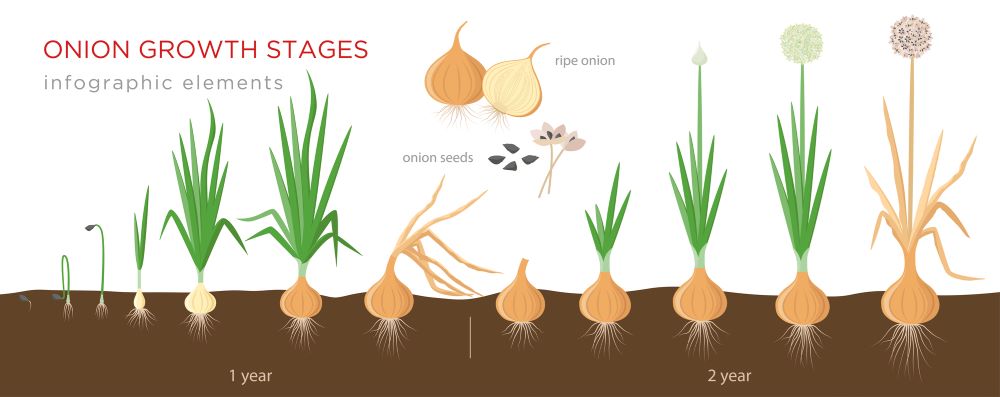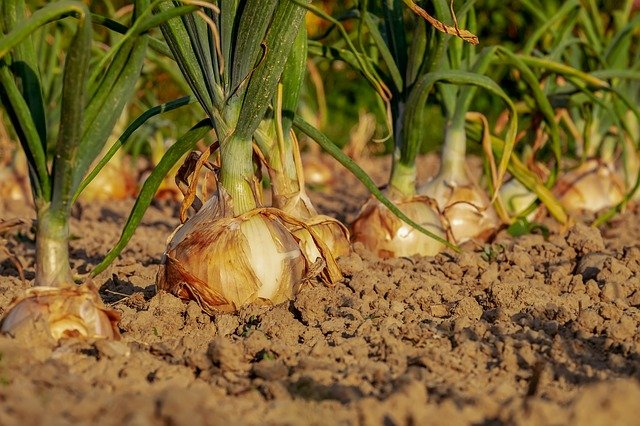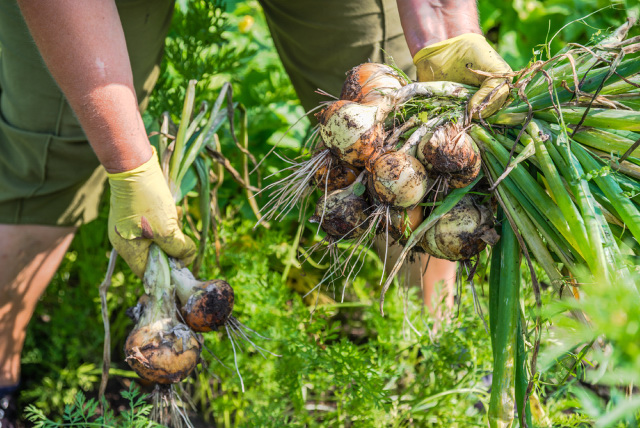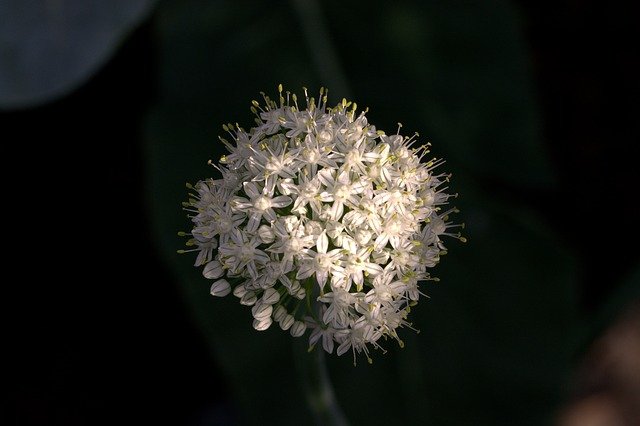If you are planning to grow onions in your home garden, it is important to understand the different growth stages of this crop. Each stage requires different care and attention from germination to maturity to ensure a successful onion harvest.

Table of Contents
How Long is an Onion Plants Lifecycle?
Onion plants have a fairly long growth cycle, typically taking 100-175 days from seed to maturity. They are biennial plants, meaning they only reach the end of their lifecycle after two years. That does not mean you can’t harvest and eat your onions after 1 year, you absolutely can!
The second year of an onion’s life cycle is when they flower and produce seeds. Knowing how onions grow will make it easier for you to care for them.

Planting
Onions can be planted in the early spring or fall. The exact planting time can vary depending on your location and climate. If you are planting in spring, you will need to wait until the temperature does not go below 28 °F (-2 °C).
If you live in a warmer climate with mild winters, you may be able to plant onions in the fall for a spring harvest. In this case, you would plant in late fall, before the first frost, so that they have time to establish roots before going dormant in the winter. Something to keep in mind is that onions can bolt during extreme temperatures.
Onions need a lot of suns, so you need to plant them where they will receive 10-12 hours of sunlight daily. Some types of onions require as much as 16 hours of sunlight per day.
Soil Conditions
Onion seeds should be planted at least 1 to 1 ½ inches deep, 2 to 3 inches apart in well-draining soil with a pH between 6.0 and 7.0.
The soil should be rich in organic matter, such as compost, to provide the seedlings with the nutrients they need to grow. If your soil lacks organic matter, you can improve soil fertility by adding a slow-release fertilizer before planting.
Onion seeds should be kept consistently moist until germination, which usually takes 6-12 days. During this time, the soil should be watered regularly, so that it does not dry out.
Stage 1: Germination
The first growth stage of onion is germination. It begins when the onion seed is planted in the soil and starts to absorb water. As the seed absorbs water, it begins to swell and eventually cracks open. The outer seed coat will split open, and a small root will emerge, followed by a tiny shoot.
The root system of the plant begins to develop during germination while the shoot pushes its way out of the soil searching for light.
It is important to keep the soil moist but not waterlogged during this stage. Overwatering can cause the onion seedling to rot, while underwatering can cause it to dry out and die.
The ideal soil temperature for onion seed germination is between 68 and 77 °F (20-25 °C). It can take 7 to 10 days for the onion seed to germinate and for the cotyledons to emerge from the soil.
Stage 2: Sprouting
Once the onion seed has germinated, and the seedling has emerged from the soil, it enters the sprouting stage. During this stage, you will notice the first shoots emerging from the ground. These first leaves or sprouts are called cotyledons or seed leaves. Sprouting occurs roughly 2 weeks after germination.
Once you notice that your onions have sprouted, you should apply fertilizer to the soil around your plant to ensure it gets enough nutrients. It is important to water your onion plants regularly making sure that the soil remains moist. I recommend applying a layer of mulch around your plants to help with water retention.
Stage 3: True Leaves Development
The true leaves formation stage is an important phase in the growth of onion plants. The true leaves are the first set of leaves that resemble the leaves of a mature onion plant.
The true leaves are a darker green than the initial sprouts and will be longer and more slender. They usually start to emerge one to three weeks after germination.
At this stage of growth, the onion plant focuses on growing larger and developing more leaves. When the plant starts producing more leaves, the stage is known as the ‘Leek ” stage. At this stage, the onion plant puts all its energy into growing its roots and leaves rather than producing a bulb. When the stems are fully developed, they become scallions or spring onions.
Once the onion seedlings have developed their second or third set of leaves, thin them out to avoid crowding. Thin the seedlings to 1 to 2 inches apart, depending on how large you want the mature onions to grow. This will allow the remaining plants to absorb more nutrients and grow larger.
Apply a nitrogen-rich fertilizer every 2 to 3 weeks to give the plants the nutrients they need. Alternatively, you can use a slow-release fertilizer when planting the seedlings to supply the nutrients over a longer period.
Stage 4: Bulb Development
The fourth growth stage of the onion plant is the stage when the onion plant begins to focus on forming a bulb. The success of this stage is determined by the amount of daylight the plant receives and depends on the variety of onions.
Long-day onions require 14-16 hours of daylight to trigger the bulbing process. Short-day onions, on the other hand, require 10-12 hours of daylight. It can take several weeks to develop a bulb.
The soil needs to be kept moist during bulb formation. If the soil is too dry, the bulbs may not form properly. The bulb development stage is exciting as soon you will begin to see bulbs peeking out of the top of the soil.

Stage 5: Maturation Stage
Your onion plant will reach maturity roughly 90 days after it was planted, although it can be as long as 120 days. When your onions have reached maturity, the bulbs are ready for harvest.
You will know your onion plants are ready for harvesting when the leaves begin to turn down or fold slightly at the top. The leaves will begin wilting and will turn yellow. This is a sign that the onion plant is no longer producing new leaves or growing.
Once the onion plant has reached maturity, it is important to stop watering it to allow the bulbs to dry out. This will help to prevent the bulbs from rotting and make them easier to store. The drying process can take anywhere from two to three weeks.
Stage 6: Harvesting

Once the onion bulbs have dried out, they are ready to be harvested. To harvest your onions, you can loosen the soil around the onion bulb with a garden fork or shovel and then gently lift the bulb out of the soil.
Be careful not to damage the onion bulb when harvesting. You should also not cut the stalk that is attached to the onion if you want to store the onions.
Once the onion bulbs have been harvested, it is important to cure them before storing them. Curing allows the onion bulbs to dry out further and helps to extend their shelf life.
To cure onions, place them in a sunny or warm spot. Onions should be left to cure for two to three weeks before they are ready for storage. Cut the stalk once the onions have been cured.
Stage 7: Vegetative Growth
The vegetative growth stage takes place in the second year of an onion plant’s life cycle. It will only happen if you leave your onion bulbs in the ground over winter.
The bulb will continue to develop, and when springtime arrives, the onion plant will undergo a similar process to germination. You will begin to see shoots spring from the ground once again.
Stage 8: Flowering Stalks
The onion plant will begin to grow tall stalks as it did when it developed its true leaves in the first year of its lifecycle. Once the plant has grown tall, you will notice that a bud will begin to form.
The bud will flower, most commonly producing white, purple, or green flowers, although this is variant dependent. When the onion plant begins to flower, it signals the beginning of the end of its lifecycle.

Stage 9: Seed Production
During this stage, the flowers of the onion plant are pollinated by pollinating insects.
Once this happens, the plant will produce onion seeds that you can harvest, store and use to plant at a later stage.
Stage 10: Senescence
The final stage of an onion plant’s life cycle is senescence. This is when the plant has no more nutrients or energy left after producing seeds.
As the senescence stage progresses, the leaves and stems of the plant begin to dry out, and the leaves will begin to yellow. The outer layers of the onion bulb also dry out and shrink.
The plant will eventually wither and die and the onion plants growth cycle is complete.
Related Reading:
